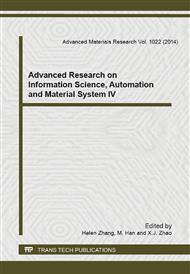p.345
p.349
p.353
p.357
p.361
p.368
p.372
p.376
p.380
Intelligent Optimization of Optimal Operating Mode in the Production Process of Copper Converter
Abstract:
In order to enhance the standard of copper converter operation,operating modes are employed to describe a group of operating parameters which need to be decided on line, and an intelligent optimization way based on neural network and improved chaos genetic algorithm for operating modes is presented. At first, the optimal samples is sieved from the historical sample set. Secondly, the functional relationship with optimization objective and technological parameters is drilled by a neural network model. At last, chaos genetic algorithm with chaotic variables is adopted to seek the optimal operating mode. This method is applied to real-time optimization of copper converter operating parameters.The running results show that the yield of converter raises by 5.9%, and the quantity of the disposed cool materials increases by 7.7%.
Info:
Periodical:
Pages:
361-367
Citation:
Online since:
August 2014
Authors:
Price:
Сopyright:
© 2014 Trans Tech Publications Ltd. All Rights Reserved
Share:
Citation:


